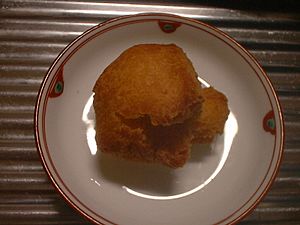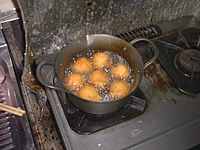Sata andagi facts for kids

A finished sata andagi
|
|
| Type | Fried dough |
|---|---|
| Place of origin | Japan |
| Region or state | Okinawa |
| Main ingredients | Flour, sugar and eggs |
Sata andagi (サーターアンダーギー, sātā andāgī) are sweet, deep-fried dough balls. They are a lot like doughnuts. These tasty treats come from Okinawa, Japan. They are also very popular in Hawaii. People there sometimes just call them "andagi."
Contents
What Are Sata Andagi?
Sata andagi are a type of fried dough. They are a popular snack in Okinawa. They are also enjoyed in Hawaii. They are often eaten as a dessert or a sweet treat.
Where Do They Come From?
Sata andagi first came from Southern China. Over time, they spread to the Japanese prefecture of Okinawa. This is why they are a big part of Okinawan cuisine.
What Does the Name Mean?
The name Sata andagi comes from the Okinawan language. Saataa means "sugar." Anda means "oil," and agii means "fried." So, andaagii together means "deep fried." This makes sense because they are sweet and cooked in oil!
How Are They Made?
Traditional Okinawan sata andagi are made with simple ingredients. These include flour, sugar, and eggs. The ingredients are mixed together to form a dough. This dough is then shaped into balls. Finally, the dough balls are deep fried until they are golden brown.
When they are cooked, sata andagi have a special texture. The outside is crispy and a bit browned. The inside is light and soft, almost like a cake.
See also
 In Spanish: Sātā andāgī para niños
In Spanish: Sātā andāgī para niños


